Exploring Sea Turtle Longevity in the Wild
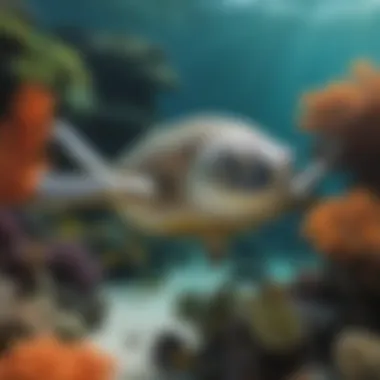
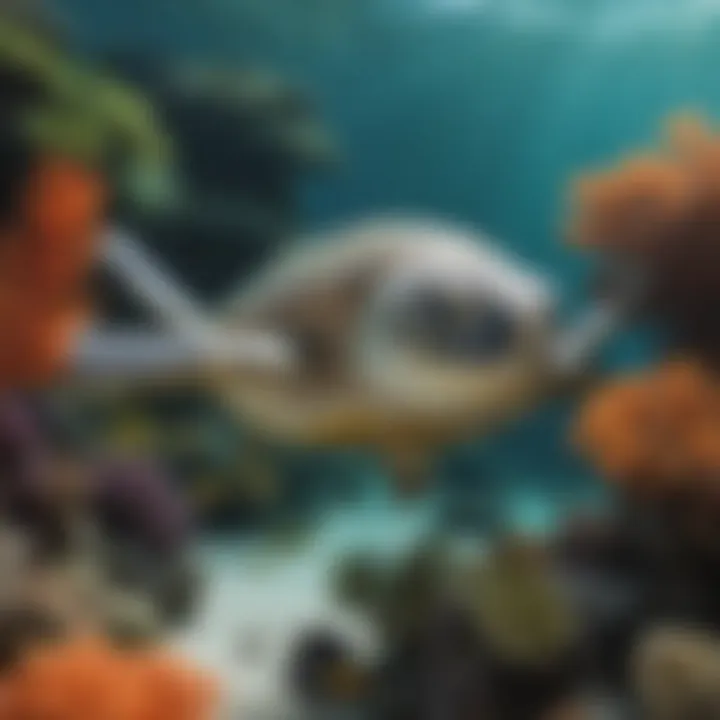
Overview of the Topic
Intro
Sea turtles are captivating creatures that have roamed the oceans for millions of years. Their longevity is one of the many wonders of their existence, making them a focal point for researchers, conservationists, and enthusiasts alike. Understanding how long these sea creatures can live in the wild is not just a matter of curiosity; it has profound implications for our marine ecosystems. Each species, from the hawksbill to the leatherback, experiences notably different lifespans influenced by their environments, mating habits, and threats.
Background Information
The significance of studying the lifespan of sea turtles lies in their role as indicators of ocean health. These reptiles contribute to the balance of marine ecosystems, particularly through their foraging habits that help maintain seagrass beds and coral reefs. Not just their age, but the conditions under which they thrive offer valuable insights into marine biodiversity. Moreover, as they journey through various stages of growth and development, their experiences reflect broader environmental challenges.
Current Status and Challenges
The Current State
In the wild, the lifespan of most sea turtles can vary widely. Some species are known to live upwards of 70 years, while others have been observed to live exceedin 100 years. However, this resilience is increasingly being tested due to a myriad of challenges in their natural habitats. Notable among these are habitat loss, climate change, and human interference.
"The survival of sea turtles is intertwined with the health of our oceans; neglect one, and the other shall suffer."
Challenges and Threats
Several factors threaten the well-being of sea turtles:
- Marine Pollution: Plastic debris is often consumed by these animals, leading to malnutrition and often death.
- Illegal Fishing: Bycatch in fishing nets remains a significant danger. Sea turtles caught in such practices often do not survive.
- Climate Change: Rising sea levels and changing ocean temperatures disrupt nesting habits. Female turtles often depend on specific beach temperatures to lay eggs, making them particularly sensitive to climate shifts.
- Coastal Development: Construction along coastlines often destroys nesting habitats, leaving many turtles without a safe place to reproduce.
Sustainable Solutions
Exploring Sustainable Practices
Protecting sea turtles requires a multifaceted approach. Organizations and dedicated individuals are adopting sustainable practices that not only aim to shield these creatures from threats but enhance their habitats. conservation efforts, habitat restoration, and awareness campaigns are crucial lifts in this fight.
- Protected Areas: Establishing marine protected areas has shown promising results, as these zones allow marine life to recuperate and thrive without interference.
- Legislation: Many countries have implemented laws restricting harmful fishing practices that can injure or kill turtles.
- Community Involvement: Educating local communities about the importance of sea turtles has led to increased stewardship of their habitats.
Case Studies
Successful conservation stories serve as beacons of hope. For instance, the efforts in Costa Rica have brought back various turtle populations due to strict law enforcement against poaching of eggs and leatherback turtle habitat protection.
Impact and Importance
Analyzing the Impact
The health of sea turtle populations serves as a bellwether for our oceans. Their predation shapes the dynamics of marine ecosystems and their decline signals deteriorating health in marine environments. The feedback loop is dangerous; as these turtles decline, the ecosystems they support start failing as well.
Emphasizing Conservation Efforts
Coordinated efforts for conservation can and do make a difference. Protecting these ancient mariners is not just an ecological duty; it’s essential for the sustainability of many marine species and even economic sectors that rely on healthy oceans, like fishing and tourism.
Understanding the lifespan of sea turtles provides a framework for future studies and conservation efforts. As research gathered and actions pointed, it’s clear that protecting sea turtles serves many purposes—stewarding our oceans and enriching our understanding of life within them.
Prelude to Sea Turtles
Understanding the world of sea turtles is vital, not just for their conservation but also for grasping the complex ecosystems they inhabit. These marine reptiles are not just fascinating due to their appearance and behaviors; they provide essential services in their environments. From maintaining seagrass beds to supporting coral reefs, their presence plays a significant role in oceanic health. This article delves into their lifespan, a crucial factor in understanding their biology, ecological role, and the influences that threaten their existence.
Overview of Sea Turtle Species
Sea turtles are a diverse group, traditionally classified into several distinct species, each with its unique characteristics and habits. Among the most recognized are the Leatherback, Green, Hawksbill, Loggerhead, and Olive Ridley turtles. Each of these species has adapted to different ecological niches, showcasing a wide range of sizes, colors, and behaviors.
- Leatherback Turtles: The largest of the sea turtles, these impressive creatures can reach lengths of 6.6 feet and weigh over 2,000 pounds. They are unique for not having a hard shell like their counterparts.
- Green Turtles: Named for the green color of their fat, they are primarily herbivorous and can often be seen grazing on seagrasses.
- Hawksbill Turtles: Highly valued for their shells, Hawksbill turtles are crucial for coral reef health, as they feed on sponges and help maintain the ecosystem's balance.
- Loggerhead Turtles: With their larger heads, Loggerheads are known for their powerful jaws that help them feed on hard-shelled prey like conchs and sea urchins.
- Olive Ridley Turtles: These turtles are famous for their unique mass nesting behavior called "arribada," where thousands gather on the same beach to lay eggs.
In trying to comprehend their longevity, knowing these species is fundamental. The lifespan of each varies significantly and is influenced by their biology and environmental factors.
Importance of Studying Lifespan
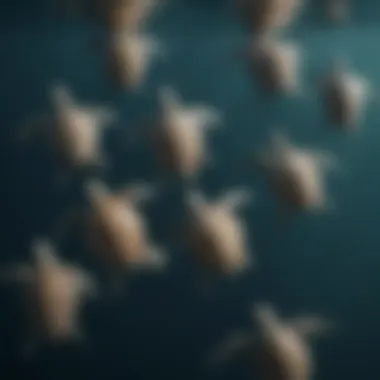
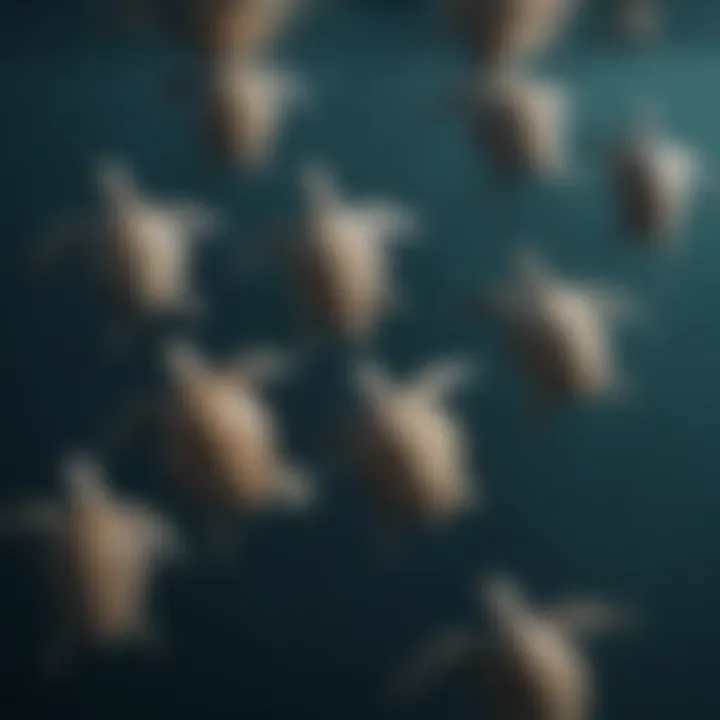
The study of sea turtle lifespan is more than an academic pursuit. It provides insights into their longevity, reproductive rates, and patterns of growth, which are essential for effective conservation strategies. Understanding how long these creatures live helps scientists gauge population dynamics and assess the vitality of their populations.
With some species like the Leatherback living up to 50 years or more, it's evident that lifespan is intertwined with multiple factors. These can include genetic predispositions and varying environmental challenges. Mating habits, developmental stages, and even the rate at which they grow are all significant variables that can influence their life expectancy and overall health.
b>In summary:b> Studying the lifespan of sea turtles sheds light on their resilience and adaptability, but it also underscores the urgent need for conservation efforts. As cherished indicators of ocean health, protecting these species is synonymous with safeguarding our marine ecosystems.
"The great balance of the ocean depends on these ancient mariners. Their survival is tied to our actions."
Understanding Sea Turtle Lifespan
Understanding the lifespan of sea turtles provides crucial insight into these remarkable creatures and their extensive journeys through life. Knowing how long they can live in the wild illuminates various aspects of their biology and ecology, as well as the different challenges they face. For conservationists and researchers, this information can guide efforts to protect these animals and ensure their survival. Each species has unique traits and behaviors that influence their life expectancy, making the study of lifespan integral to broader conservation goals.
Average Lifespan by Species
Leatherback Turtles
Leatherback turtles are the largest of all sea turtles, often weighing over 2,000 pounds. Their lifespan can reach up to 50 years in the wild, depending on various factors such as predation and environmental conditions. The notable aspect of leatherbacks is their ability to dive deeper than any other turtle species, plunging down to around 4,000 feet! This capability gives them access to unique food sources, particularly jellyfish, which form a major part of their diet. This dietary flexibility is an advantage since it reduces competition for food and potentially allows them to thrive in various environments.
Green Turtles
Green turtles, known for their unique greenish fat, typically have a lifespan ranging from 60 to 80 years. One key characteristic of green turtles is their herbivorous diet, primarily consisting of seagrasses and algae. This particular eating habit assists not only in their growth but also in maintaining healthy marine ecosystems, making green turtles a significant player in coastal environments. Their long lifespan allows them to contribute to the ecological balance over many decades, reinforcing the need to protect their habitats against degradation.
Hawksbill Turtles
Hawksbill turtles are renowned for their strikingly beautiful shells, which are highly valued in the illegal trade market. Their lifespan in the wild can reach around 30 to 50 years. The defining feature of hawksbills is their specialized beak, enabling them to feed on sponges and other marine organisms that might be less accessible to other turtles. This unique feeding strategy is beneficial, as it places them in a niche that reduces competition. However, their unfortunate association with the illegal trade poses significant risks to their overall populations and longevity in the wild.
Loggerhead Turtles
Loggerhead turtles are famous for their large heads and robust build. These turtles can live from 50 to 70 years, which allows them a prolonged period to mate and reproduce. The notable characteristic of loggerheads is their migratory behavior; they travel vast distances to nesting sites. This migration is essential for genetic diversity and maintaining healthy populations. While their lifespan and ability to travel come with advantages, loggerheads also face various human-induced threats that can drastically affect their numbers.
Olive Ridley Turtles
Olive ridley turtles often exhibit the shortest lifespan, ranging between 30 to 50 years. They are known for their unique arribada nesting behavior, where thousands come ashore simultaneously to lay eggs. This strategy ensures a higher chance of hatchling survival through sheer numbers. However, the overlapping of nesting can lead to increased vulnerability to predators and human interference. The unique feature of their nesting behavior may be a double-edged sword, serving both as an advantage in terms of numbers and as a liability due to the risks involved.
Factors Influencing Lifespan
Genetic Factors
Genetic factors play a critical role in the lifespan of sea turtles. Each species possesses distinct genetic traits that can affect resilience against diseases or environmental stressors. The variability in these genes contributes to the overall health and longevity of the turtles. Importantly, some populations may have genetic adaptations that enable them to survive better in certain environments, which can alter their life expectancy positively or negatively depending on prevailing conditions.
Environmental Conditions
Environmental conditions significantly influence sea turtle lifespans. Adequate sea and nesting habitat, temperature, and food availability all determine how well turtles can thrive. For instance, rising sea temperatures can affect nesting sites and food resources, impacting their populations overall. Furthermore, the quality of coastal habitats is also paramount; healthy ecosystems generally lead to healthier turtle populations, reinforcing the importance of environmental conservation efforts.
Human Impact
Human impact remains a principal factor shaping the lifespan of sea turtles today. Activities such as pollution, fishing practices, and coastal development all threaten their survival. For example, bycatch from fishing gear can lead to reduced populations, while pollution can significantly affect their health and reproductive success. Despite the impressive adaptations of sea turtles, these human-induced factors often outstrip their natural resilience, leading to declines in their numbers. It’s essential to recognize and address these challenges to increase their chances of survival in the wild.
Growth and Maturity Stages
Understanding the growth and maturity stages of sea turtles is crucial for comprehending their overall lifespan and survival in the wild. This phase not only defines their transition from hatchlings to adults but also highlights the challenges they face during crucial developmental periods. Juvenile sea turtles, as one of the most vulnerable stages in their life, often encounter various threats that can drastically reduce their chances of survival. Many people overlook this stage, yet it plays a significant role in shaping the future generations of these majestic creatures.
Growth and maturity in sea turtles are influenced by several factors, including species, environment, and available resources. Monitoring these patterns gives us insight into population dynamics and can better inform conservation strategies. Furthermore, knowing when sea turtles reach sexual maturity is essential for understanding their reproductive potential and ensuring successful conservation efforts.
Juvenile Growth Patterns
Juvenile growth patterns vary significantly among different species of sea turtles. These young turtles undergo rapid growth during the first few years of life, mainly shaped by their habitat and diet. In general, hatchlings measure around 2 to 4 inches in carapace length but can grow quite quickly. For instance, green turtles can grow up to 10 to 15 inches in their first five years with abundant food sources in their environment, while leatherbacks can surpass this growth significantly, reaching lengths of over 20 inches before they settle into deeper waters.
Several factors drive the growth rate:
- Food Availability: Turtles that inhabit regions rich in seagrass or jellyfish tend to thrive and grow larger, making their journey safer.
- Temperature Regulation: Colder waters can slow growth, whereas warmer temperatures generally encourage faster development.
- Behavioral Patterns: Some species, like loggerhead turtles, migrate long distances and adapt their growth rate based on the variety of prey encountered.

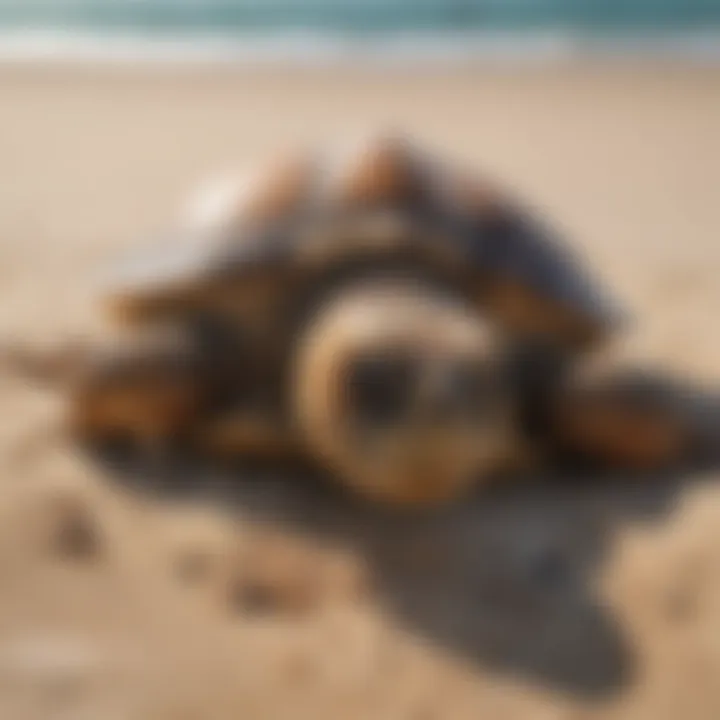
The juvenile stage lasts until the turtles reach sexual maturity, which can take anywhere from 10 to 50 years, depending on the species. Adverse conditions, such as pollution or habitat destruction, can interfere with growth, making it vital to monitor these young animals’ environments.
Reaching Sexual Maturity
The journey to sexual maturity is a pivotal moment in the lifecycle of sea turtles. This stage is not merely calculated by age but also corresponds to their size and the ecological conditions of their habitat. Typically, sea turtles reach maturity between 20 and 50 years, which means they spend a significant part of their lives growing before they can reproduce.
Each species exhibits different patterns:
- Leatherback Turtles: They tend to mature later, usually around 15 to 30 years, and can grow considerably larger, as females can exceed 1,000 pounds.
- Green Turtles: Often mature around 25 years but can sometimes breed at a younger age, depending on environmental conditions.
The age of maturity has ecological consequences. For example, populations that mature slower face greater risks due to low reproduction rates. It is also essential to understand that once they reach maturity, males often do not return to shore frequently, while females migrate back to nest, making those nesting sites critical.
"The space and conditions that juvenile sea turtles grow in directly impact their chances to reach maturity and breed successfully."
Natural Predators and Threats
Understanding the dynamics between sea turtles and their natural predators is crucial to comprehending their lifespan in the wild. Sea turtles, while fascinating and resilient, are not without their challenges. This section explores the pertinent threats posed by both natural predators and human actions, painting a vivid picture of the hurdles these remarkable creatures must navigate to survive.
Predation in the Wild
Sharks
Sharks are often viewed as apex predators, and their role in the ocean is undeniably significant. For sea turtles, these powerful hunters can pose a serious threat. Many species of sharks, such as the great white and tiger shark, are known to predate on juvenile sea turtles, taking advantage of their smaller size and relative inexperience in the vast ocean.
The key characteristic of sharks lies in their speed and predatory skills, making them formidable foes in the aquatic world. Something remarkable about sharks is their ability to sense movement in the water, which plays a significant role during hunting. While sea turtles are well-adapted to evade danger most times, they cannot always escape the scrutiny of a lurking shark. This aspect highlights the natural balance of marine ecosystems, where predators play a role in controlling turtle populations.
Sharks, however, are not the only concern for sea turtles in their habitat. They contribute positively to marine biodiversity, reminding us that all species serve a purpose, even ones that pose a threat.
Other Marine Animals
Other marine predators also impact the survival rates of sea turtles. Larger fish, like barracudas, and various sea birds can be a threat to hatchlings and juveniles. The young turtles, often making their way to the water after hatching, are at their most vulnerable. For instance, seagulls can swoop down to snatch up a hatchling before it even makes it to the safety of the waves.
It's interesting to note that different species of sea turtles may face different levels of predation based on their habitat. Some turtles find refuge in coral reefs, where they can better hide from predators, while others don’t have that luxury. This variability in habitat makes it a compelling addition to the discussion of threats to their lifespan. The unique features of these marine predators highlight the intricate web of life and the challenges that sea turtles must face within it.
Human-Induced Threats
Shifting our focus to human-inflicted dangers, the impact we have on sea turtle populations is alarming and complex. By examining the various aspects of how our actions affect these creatures, we get a clearer picture of their struggles in the wild.
Pollution
Pollution has emerged as one of the most pressing threats to sea turtles. Chemicals, plastics, and other waste infiltrate oceans, often leading to dire repercussions for the turtles. The ingestion of plastic is particularly concerning, as turtles often mistake these foreign materials for food. This can lead to blockages in their digestive systems, resulting in severe health issues or even death.
Moreover, chemical pollutants like pesticides can accumulate in their bodies, contributing to a host of health problems affecting their lifespans. By shedding light on this distressing reality, it becomes increasingly clear that the fight against pollution is paramount for the well-being of sea turtles and marine ecosystems.
Overfishing
The overfishing of turtles in numerous areas also threatens their survival. Many fishing practices unintentionally catch sea turtles as bycatch, leading to fatalities. As fisheries deplete, the competition for food increases, which can negatively affect turtle populations that already face significant challenges.
Highlighting the repercussions of overfishing emphasizes a chain reaction; the demise of one species impacts many others, weaving a complex tapestry of marine life interactions. Being conscious of fishing practices and advocating for sustainable methods is essential for the conservation of sea turtles and other marine creatures.
Coastal Development
Lastly, coastal development poses a significant hindrance to the survival of sea turtles. The destruction of nesting habitats due to urban expansion, tourism, and oil drilling can disrupt their breeding cycles. Not only do the turtles lose potential nesting sites, but the lights from coastal structures can disorient hatchlings as they navigate toward the ocean after birth.
The competitive nature of coastal resource utilization highlights the need for balance. While human development is essential, so is the protection of marine life. By recognizing the unique challenges posed by coastal development, we can strive towards implementation of smarter, more eco-friendly solutions that preserve both coastal ecosystems and the turtles' breeding habits.
"In the grand scheme of things, preserving the lives of sea turtles directly correlates with the health of our oceans and the intricate balance of marine biodiversity."
Through acknowledgement and action, we can collectively contribute to the longevity and resilience of these incredible creatures.
Mating and Reproductive Patterns
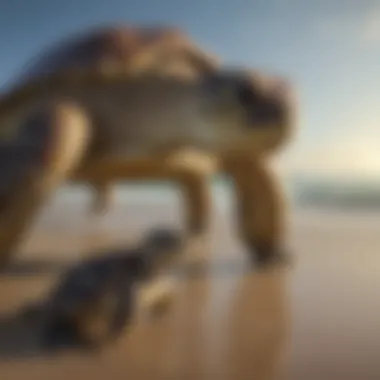
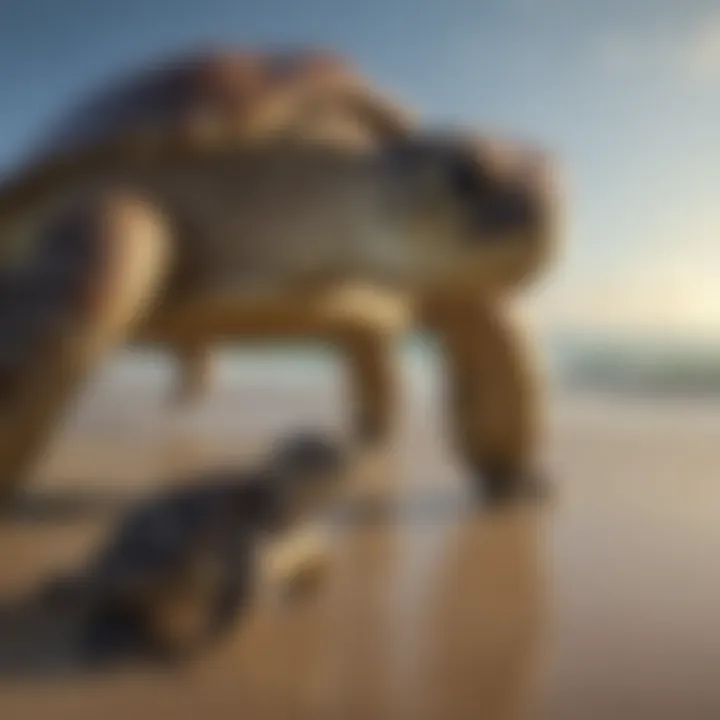
Mating and reproduction are cornerstones in the lifecycle of sea turtles, shaping not only their populations but also influencing their longevity in the wild. Understanding these processes reveals insights into their ecological roles and ways to bolster their survival. Effective reproduction means more hatchlings can enter the environment, contributing to the overall sea turtle population and maintaining ecological balance. The successful transition from mating to hatching is a dance of biological rhythms, influenced by a multitude of factors, making it crucial to dive deep into these patterns.
Mating Behavior and Cycle
Sea turtles exhibit unique mating behaviors that vary among species. They tend to be highly migratory, often traveling hundreds of miles to find suitable mates. For example, loggerhead turtles have been observed returning to the same nesting grounds year after year, suggesting a strong site fidelity that plays a role in their reproductive strategy. During mating season, males compete for females, often engaging in physical displays or behaviors to assert dominance.
The mating cycle generally takes place in the warmer months when the water temperatures rise, allowing for greater activity levels. Interestingly, female sea turtles can store sperm for several years. This ability means that even if a female does not encounter a male for a while, she can still fertilize her eggs. This adaptability is key for species survival, especially considering that some populations face human-related challenges that might reduce male presence.
Overall, the mating behaviors and cycles of sea turtles not only ensure species continuation but also indicate the health of marine environments they inhabit. By studying these patterns, we gather information that can aid conservation efforts.
Nesting and Hatchling Survival
Nesting sites are critical for the reproductive success of sea turtles. Females return to specific beaches to lay their eggs, often nesting at night to avoid predators. Each nesting event can yield over a hundred eggs, which are deposited in sandy pits. The choice of nesting beach can be influenced by factors like temperature and disturbance. The health of those beaches is pivotal; if pollution or development encroaches on nesting sites, it can jeopardize the delicate balance of their reproductive cycle.
Once the eggs hatch, the hatchlings face immense challenges as they make their way to the ocean. Predation from crabs, birds, and even other fish threatens their survival. Environmental conditions like sand temperature and humidity also play a significant role in hatchlings' emergence and immediate survival. Warmer sands can expedite the hatching process, but if temperatures get too high, it could adversely affect the developing embryos.
Hatchling orientation towards the ocean in response to natural light is a fascinating aspect of their survival strategy. Unfortunately, artificial lights can disorient them, leading them away from safety. Consequently, protecting nesting sites and ensuring hatchlings' safe passage are critical steps in conservation efforts. A successful nesting season translates into more juveniles entering the ocean, providing potential for population recovery.
"Protecting nesting habitats is not just a benefit for turtles; it preserves entire ecosystems that rely on their existence."
Understanding the nuances of mating and reproductive patterns in sea turtles gives us the needed perspective on challenges these creatures face and the how we can contribute to their preservation. This knowledge can empower conservationists and encourage global efforts aimed at safeguarding these magnificent marine reptiles.
Conservation Efforts
Conservation efforts for sea turtles are crucial to ensuring the survival of these ancient creatures. As they navigate through various threats—both natural and human-made—the significance of proactive measures becomes evident. Acting as a bridge between generations, conservation initiatives aim not only to protect individual species but also to maintain the delicate marine ecosystems they inhabit. If we reflect on their long lifespan in the wild, we find that every growing year is a testament to the resilience of sea turtles against adversity. Thus, investing in their conservation can yield benefits that echo throughout time.
Global Conservation Initiatives
Worldwide, several organizations have dedicated themselves to safeguarding sea turtles through comprehensive conservation strategies. These efforts often encompass a blend of research, habitat restoration, community involvement, and policy development. Renowned institutions like The World Wildlife Fund and Sea Turtle Conservancy engage in projects that focus on protecting nesting sites and reducing bycatch, where unintended catch impacts sea turtle populations.
Some key actions taken include:
- Legislation Enforcement: Strong laws like the Endangered Species Act in the United States help regulate activities that could harm sea turtles.
- International Treaties: Agreements such as the Convention on Migratory Species aim to coordinate global efforts in preserving migratory species like sea turtles.
- Research Initiatives: Ongoing studies monitored by agencies promote scholarship deciphering the intricate life cycles and migratory patterns of sea turtles, leading to informed conservation decisions.
Each initiative embodies a collective understanding that preserving these animals transcends borders, requiring cooperation across nations and disciplines.
Local Conservation Projects
Local conservation efforts play an equally vital role in the protection of sea turtles. Communities around coastal regions are fording the path to recovery. These grassroots initiatives not only engage locals but also foster a sense of ownership towards marine stewardship. Each project represents a mosaic of unique cultural practices and ecological knowledge that personalize the fight to ensure sea turtles thrive. Here are some notable examples:
- Nesting Site Protection: Community-led projects often monitor beaches where sea turtles nest, providing necessary protection from developers or illegal activities.
- Awareness Campaigns: Education projects in schools and local neighborhoods raise awareness about the importance of sea turtles and the threats they face. Creating a culture of concern fosters active participation in conservation.
- Beach Clean-Up Initiatives: Local volunteers join forces for beach clean-up days, removing harmful plastics and debris that could entangle or harm sea turtles.
"By supporting local conservation projects, communities can play an essential role in ensuring that future generations inherit a healthy, vibrant ocean filled with turtles."
Overall, conservation efforts—be it global or local—represent a symbiotic relationship where taking care of sea turtles contributes to the health of marine ecosystems and communities, validating the interconnectedness of life in our oceans. Keeping an eye on the horizon, the hope is to see these magnificent creatures flourish for years to come.
Closure: The Future of Sea Turtles
An exploration into the lifespan of sea turtles leads us inevitably to consider their future—a future that is increasingly precarious but not devoid of hope. Understanding the longevity of these ancient mariners sheds light on the intricate webs of life they inhabit and the pressing threats they face. As we conclude this article, it is imperative to reflect on the steps needed for conservation, the importance of awareness, and our role in safeguarding these remarkable beings.
There are specific elements that need to be emphasized when talking about the future of sea turtles. By grasping their lifespan and lifecycle, conservationists can formulate more effective strategies to protect their habitats, develop responsible fisheries policies, and enhance nesting site protections. The benefits of these actions are twofold: they not only safeguard sea turtles but also nurture the broader marine ecosystem that relies on them, creating a balance that benefits all forms of life in our oceans.
The Role of Education and Advocacy
Education is the bedrock of successful conservation efforts. Increasing awareness about the plight of sea turtles nurtures a sense of responsibility among individuals and communities. Educational programs in schools, as well as local workshops, can highlight the importance of sea turtles, inspiring the next generation to become stewards of the ocean.
Advocacy plays a crucial role in amplifying these voices. Organizations like the Sea Turtle Conservancy advocate for policies that protect critical marine habitats. Collaborative efforts between local authorities, environmental groups, and community members can lead to sustainable practices.
Through education and advocacy, we can foster a culture of respect for sea turtles. It’s not just about facts and figures; it’s about stories—stories of resilience and survival that connect us to these magnificent creatures, making the issue personal and actionable.
Call to Action for Conservation
A call to action is essential for the survival of sea turtles. Each individual can contribute to conservation efforts in several impactful ways:
- Participate in Beach Cleanups: Removing waste from coastal areas prevents sea turtles from mistaking trash for food.
- Support Sustainable Seafood: Choosing seafood from responsible fisheries helps maintain the delicate marine balance.
- Advocate for Stronger Protection Laws: Voice support for policies that safeguard nesting sites and marine habitats.
- Become a Citizen Scientist: Engage in local monitoring efforts of nesting sites or tracking sea turtle activities.
"The greatest threat to our planet is the belief that someone else will save it." - Robert Swan
These actions, though they may seem small in isolation, accumulate to form a wave of real change. Collectively, as informed members of society, we have the power to alter the course of history for sea turtles. Every effort counts, and through each initiative, whether it be local or global, the chance to diminish threats to these persevering creatures improves.
In summary, the future of sea turtles hinges on our willingness to take part in their conservation and advocacy. By educating ourselves and others, advocating for strong protective measures, and actively participating in conservation efforts, we can pave the way for a harmonious existence that respects and honors the remarkable legacy of sea turtles in the wild.



